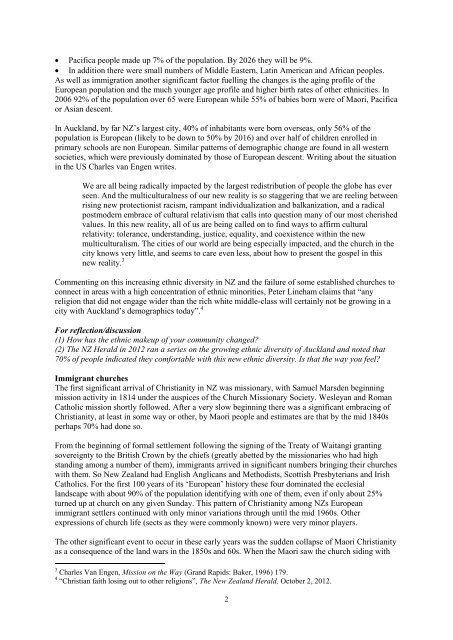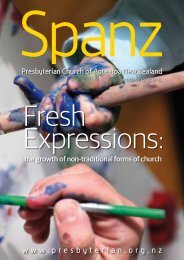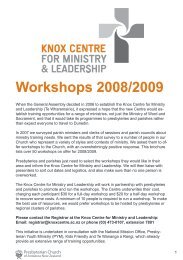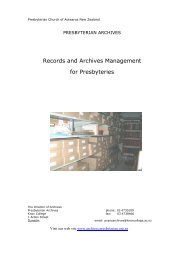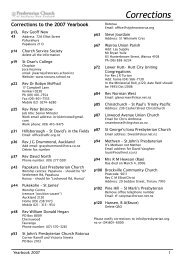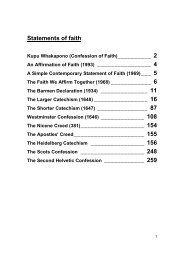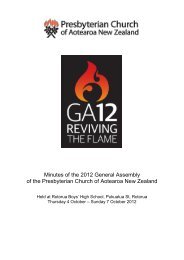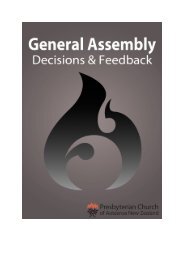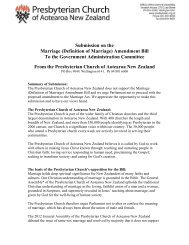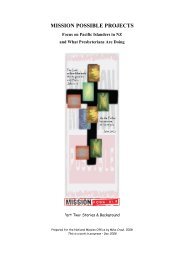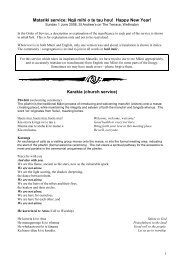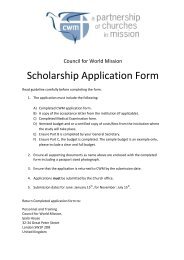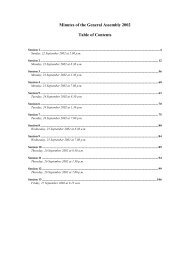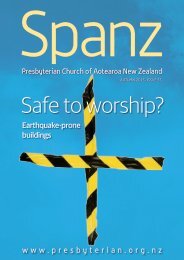Cultural diversity and unity in Christ: the Presbyterian Church of ...
Cultural diversity and unity in Christ: the Presbyterian Church of ...
Cultural diversity and unity in Christ: the Presbyterian Church of ...
Create successful ePaper yourself
Turn your PDF publications into a flip-book with our unique Google optimized e-Paper software.
Pacifica people made up 7% <strong>of</strong> <strong>the</strong> population. By 2026 <strong>the</strong>y will be 9%.<br />
In addition <strong>the</strong>re were small numbers <strong>of</strong> Middle Eastern, Lat<strong>in</strong> American <strong>and</strong> African peoples.<br />
As well as immigration ano<strong>the</strong>r significant factor fuell<strong>in</strong>g <strong>the</strong> changes is <strong>the</strong> ag<strong>in</strong>g pr<strong>of</strong>ile <strong>of</strong> <strong>the</strong><br />
European population <strong>and</strong> <strong>the</strong> much younger age pr<strong>of</strong>ile <strong>and</strong> higher birth rates <strong>of</strong> o<strong>the</strong>r ethnicities. In<br />
2006 92% <strong>of</strong> <strong>the</strong> population over 65 were European while 55% <strong>of</strong> babies born were <strong>of</strong> Maori, Pacifica<br />
or Asian descent.<br />
In Auckl<strong>and</strong>, by far NZ’s largest city, 40% <strong>of</strong> <strong>in</strong>habitants were born overseas, only 56% <strong>of</strong> <strong>the</strong><br />
population is European (likely to be down to 50% by 2016) <strong>and</strong> over half <strong>of</strong> children enrolled <strong>in</strong><br />
primary schools are non European. Similar patterns <strong>of</strong> demographic change are found <strong>in</strong> all western<br />
societies, which were previously dom<strong>in</strong>ated by those <strong>of</strong> European descent. Writ<strong>in</strong>g about <strong>the</strong> situation<br />
<strong>in</strong> <strong>the</strong> US Charles van Engen writes.<br />
We are all be<strong>in</strong>g radically impacted by <strong>the</strong> largest redistribution <strong>of</strong> people <strong>the</strong> globe has ever<br />
seen. And <strong>the</strong> multiculturalness <strong>of</strong> our new reality is so stagger<strong>in</strong>g that we are reel<strong>in</strong>g between<br />
ris<strong>in</strong>g new protectionist racism, rampant <strong>in</strong>dividualization <strong>and</strong> balkanization, <strong>and</strong> a radical<br />
postmodern embrace <strong>of</strong> cultural relativism that calls <strong>in</strong>to question many <strong>of</strong> our most cherished<br />
values. In this new reality, all <strong>of</strong> us are be<strong>in</strong>g called on to f<strong>in</strong>d ways to affirm cultural<br />
relativity: tolerance, underst<strong>and</strong><strong>in</strong>g, justice, equality, <strong>and</strong> coexistence with<strong>in</strong> <strong>the</strong> new<br />
multiculturalism. The cities <strong>of</strong> our world are be<strong>in</strong>g especially impacted, <strong>and</strong> <strong>the</strong> church <strong>in</strong> <strong>the</strong><br />
city knows very little, <strong>and</strong> seems to care even less, about how to present <strong>the</strong> gospel <strong>in</strong> this<br />
new reality. 3<br />
Comment<strong>in</strong>g on this <strong>in</strong>creas<strong>in</strong>g ethnic <strong>diversity</strong> <strong>in</strong> NZ <strong>and</strong> <strong>the</strong> failure <strong>of</strong> some established churches to<br />
connect <strong>in</strong> areas with a high concentration <strong>of</strong> ethnic m<strong>in</strong>orities, Peter L<strong>in</strong>eham claims that “any<br />
religion that did not engage wider than <strong>the</strong> rich white middle-class will certa<strong>in</strong>ly not be grow<strong>in</strong>g <strong>in</strong> a<br />
city with Auckl<strong>and</strong>’s demographics today”. 4<br />
For reflection/discussion<br />
(1) How has <strong>the</strong> ethnic makeup <strong>of</strong> your comm<strong>unity</strong> changed?<br />
(2) The NZ Herald <strong>in</strong> 2012 ran a series on <strong>the</strong> grow<strong>in</strong>g ethnic <strong>diversity</strong> <strong>of</strong> Auckl<strong>and</strong> <strong>and</strong> noted that<br />
70% <strong>of</strong> people <strong>in</strong>dicated <strong>the</strong>y comfortable with this new ethnic <strong>diversity</strong>. Is that <strong>the</strong> way you feel?<br />
Immigrant churches<br />
The first significant arrival <strong>of</strong> <strong>Christ</strong>ianity <strong>in</strong> NZ was missionary, with Samuel Marsden beg<strong>in</strong>n<strong>in</strong>g<br />
mission activity <strong>in</strong> 1814 under <strong>the</strong> auspices <strong>of</strong> <strong>the</strong> <strong>Church</strong> Missionary Society. Wesleyan <strong>and</strong> Roman<br />
Catholic mission shortly followed. After a very slow beg<strong>in</strong>n<strong>in</strong>g <strong>the</strong>re was a significant embrac<strong>in</strong>g <strong>of</strong><br />
<strong>Christ</strong>ianity, at least <strong>in</strong> some way or o<strong>the</strong>r, by Maori people <strong>and</strong> estimates are that by <strong>the</strong> mid 1840s<br />
perhaps 70% had done so.<br />
From <strong>the</strong> beg<strong>in</strong>n<strong>in</strong>g <strong>of</strong> formal settlement follow<strong>in</strong>g <strong>the</strong> sign<strong>in</strong>g <strong>of</strong> <strong>the</strong> Treaty <strong>of</strong> Waitangi grant<strong>in</strong>g<br />
sovereignty to <strong>the</strong> British Crown by <strong>the</strong> chiefs (greatly abetted by <strong>the</strong> missionaries who had high<br />
st<strong>and</strong><strong>in</strong>g among a number <strong>of</strong> <strong>the</strong>m), immigrants arrived <strong>in</strong> significant numbers br<strong>in</strong>g<strong>in</strong>g <strong>the</strong>ir churches<br />
with <strong>the</strong>m. So New Zeal<strong>and</strong> had English Anglicans <strong>and</strong> Methodists, Scottish <strong>Presbyterian</strong>s <strong>and</strong> Irish<br />
Catholics. For <strong>the</strong> first 100 years <strong>of</strong> its ‘European’ history <strong>the</strong>se four dom<strong>in</strong>ated <strong>the</strong> ecclesial<br />
l<strong>and</strong>scape with about 90% <strong>of</strong> <strong>the</strong> population identify<strong>in</strong>g with one <strong>of</strong> <strong>the</strong>m, even if only about 25%<br />
turned up at church on any given Sunday. This pattern <strong>of</strong> <strong>Christ</strong>ianity among NZs European<br />
immigrant settlers cont<strong>in</strong>ued with only m<strong>in</strong>or variations through until <strong>the</strong> mid 1960s. O<strong>the</strong>r<br />
expressions <strong>of</strong> church life (sects as <strong>the</strong>y were commonly known) were very m<strong>in</strong>or players.<br />
The o<strong>the</strong>r significant event to occur <strong>in</strong> <strong>the</strong>se early years was <strong>the</strong> sudden collapse <strong>of</strong> Maori <strong>Christ</strong>ianity<br />
as a consequence <strong>of</strong> <strong>the</strong> l<strong>and</strong> wars <strong>in</strong> <strong>the</strong> 1850s <strong>and</strong> 60s. When <strong>the</strong> Maori saw <strong>the</strong> church sid<strong>in</strong>g with<br />
3 Charles Van Engen, Mission on <strong>the</strong> Way (Gr<strong>and</strong> Rapids: Baker, 1996) 179.<br />
4 “<strong>Christ</strong>ian faith los<strong>in</strong>g out to o<strong>the</strong>r religions”, The New Zeal<strong>and</strong> Herald, October 2, 2012.<br />
2


